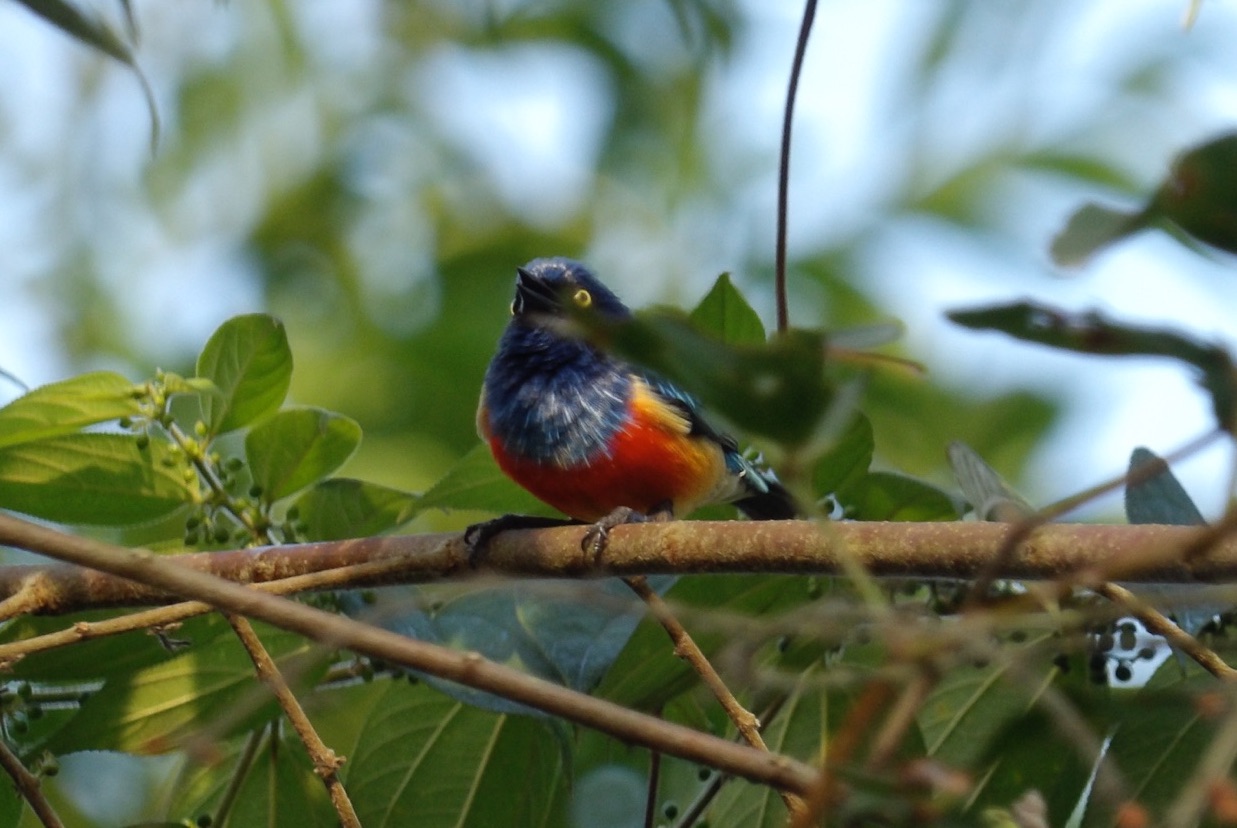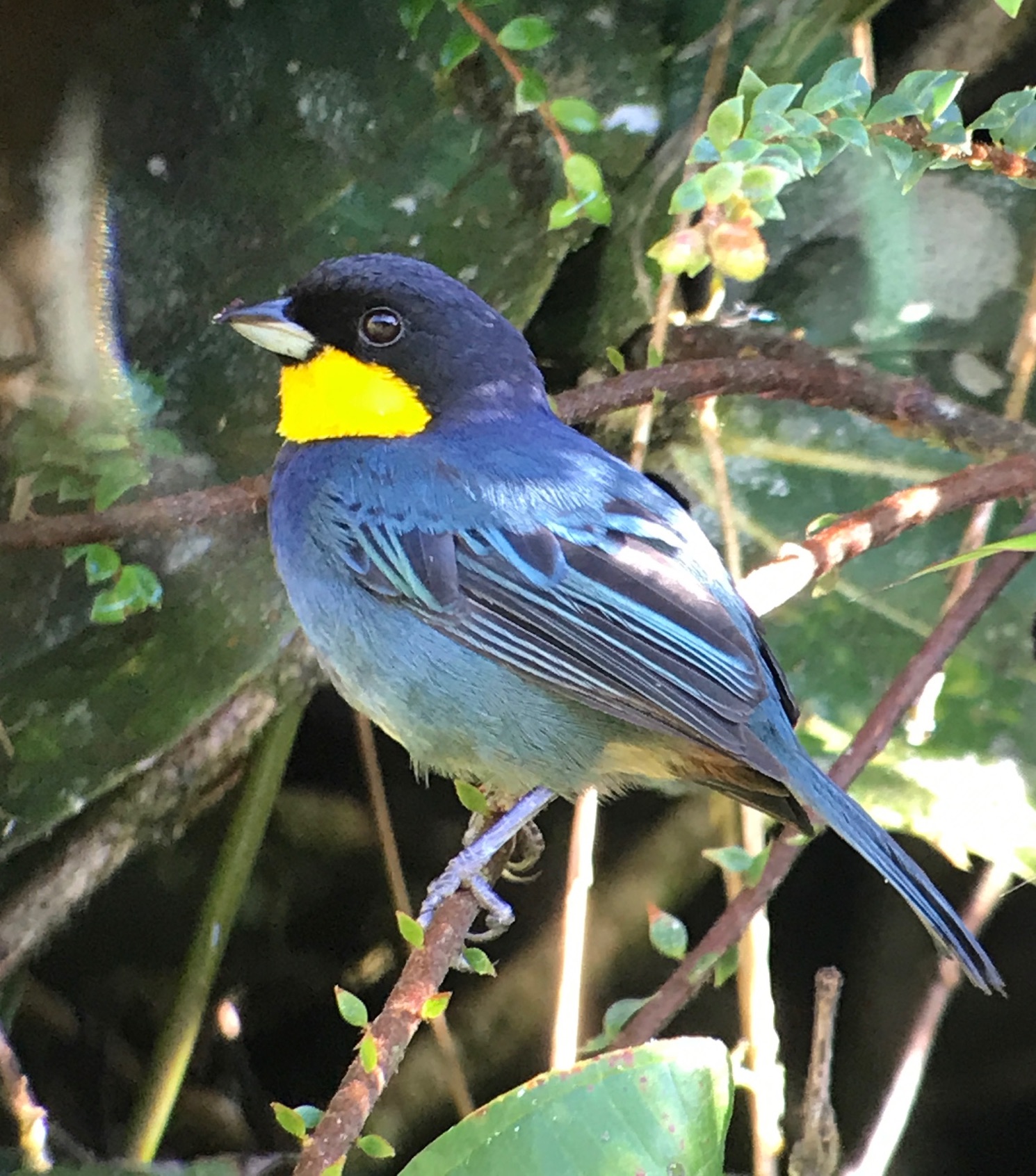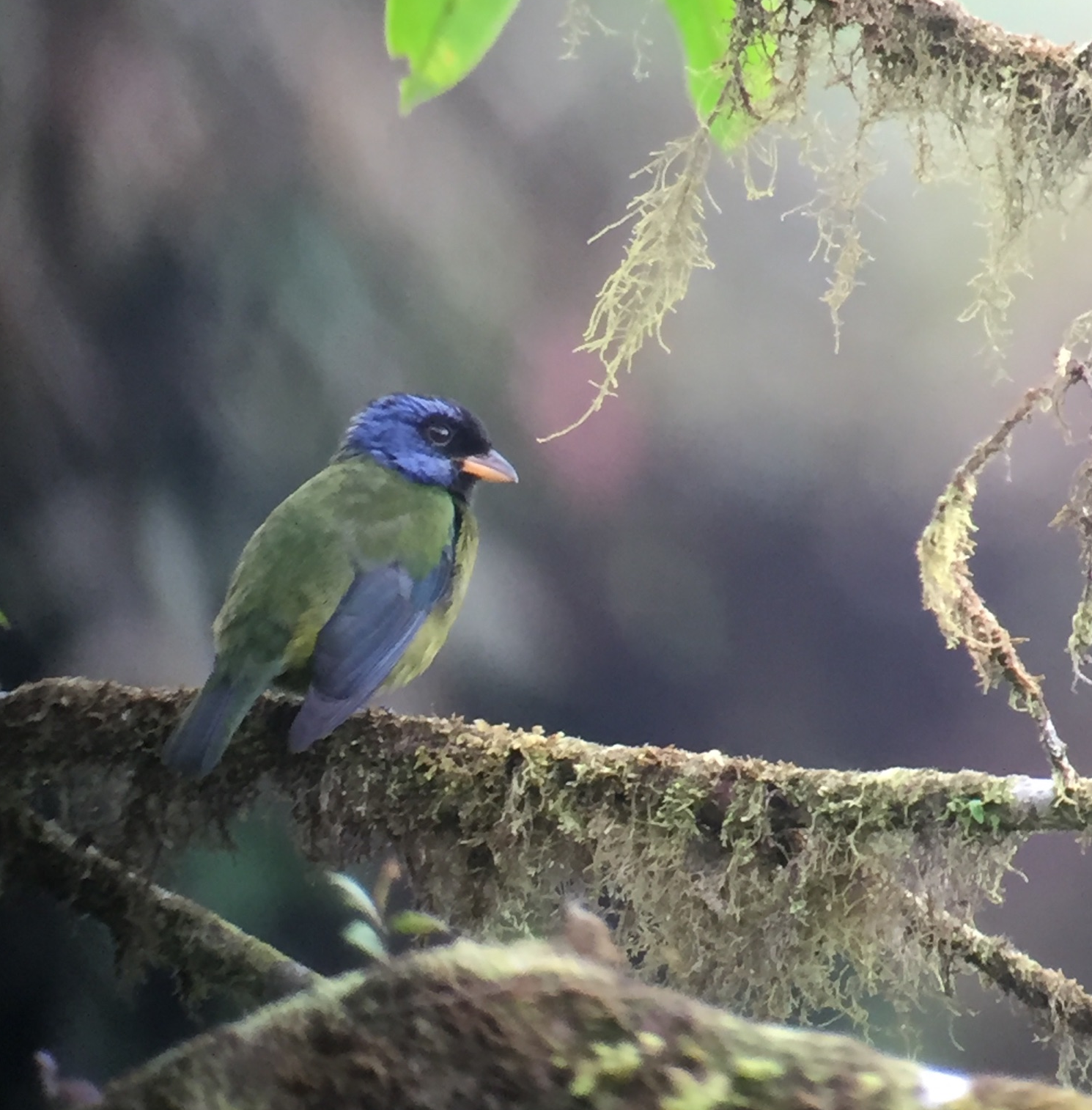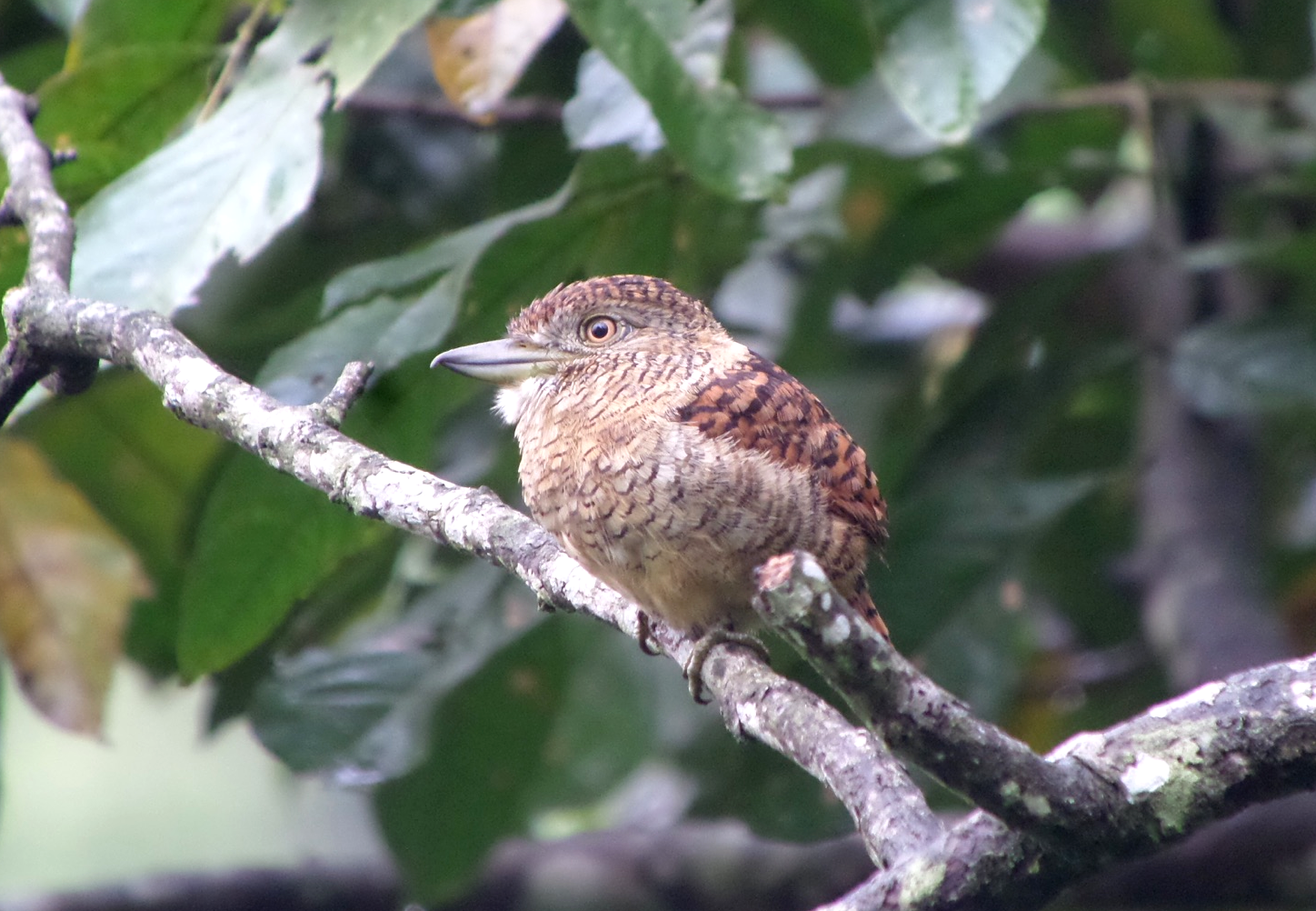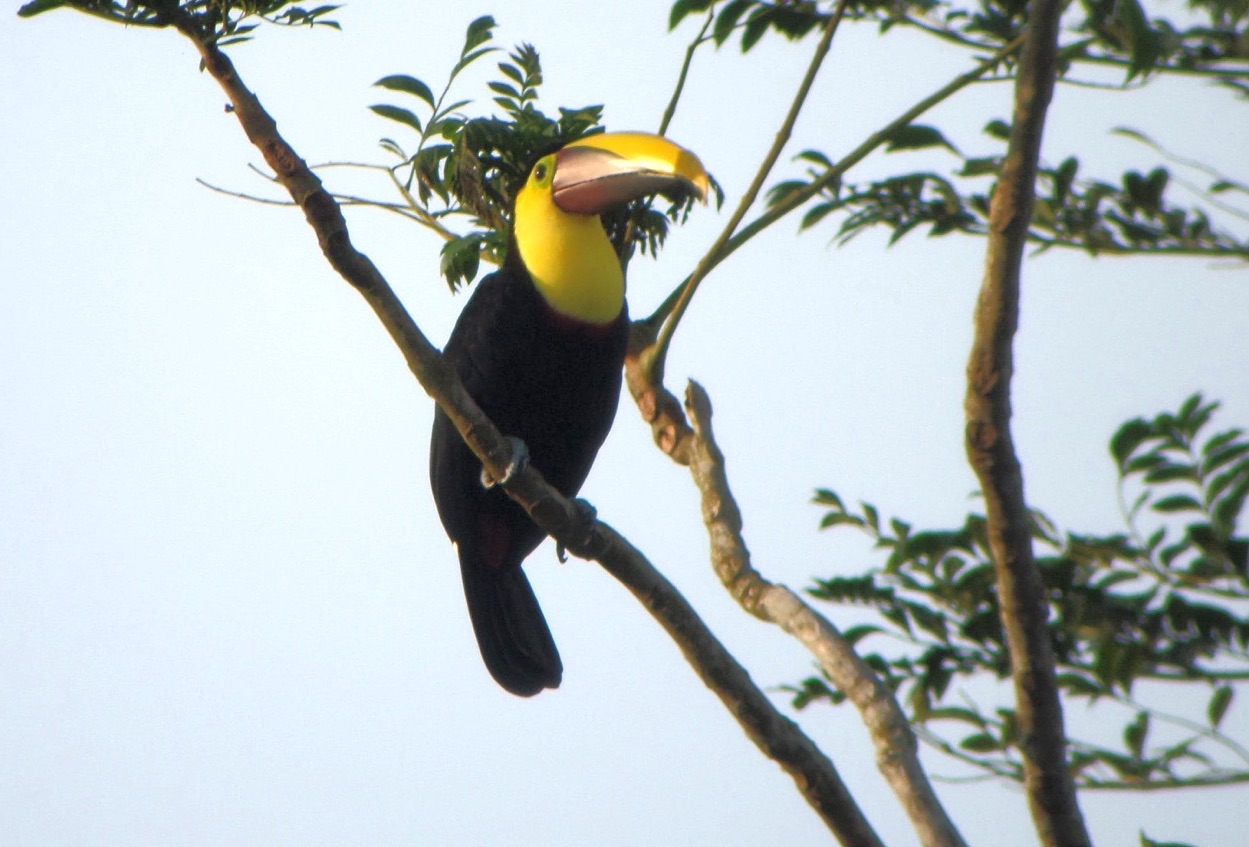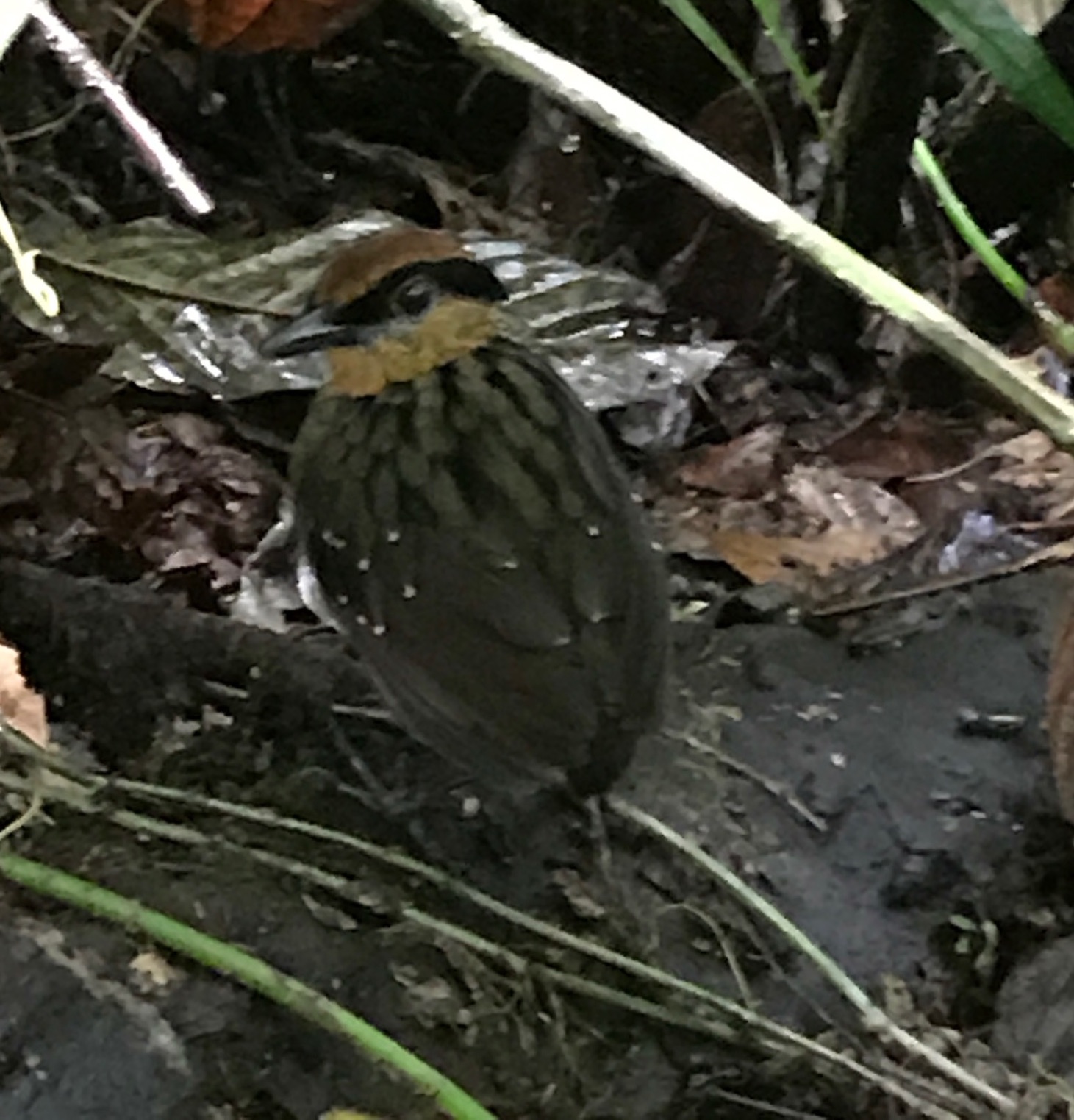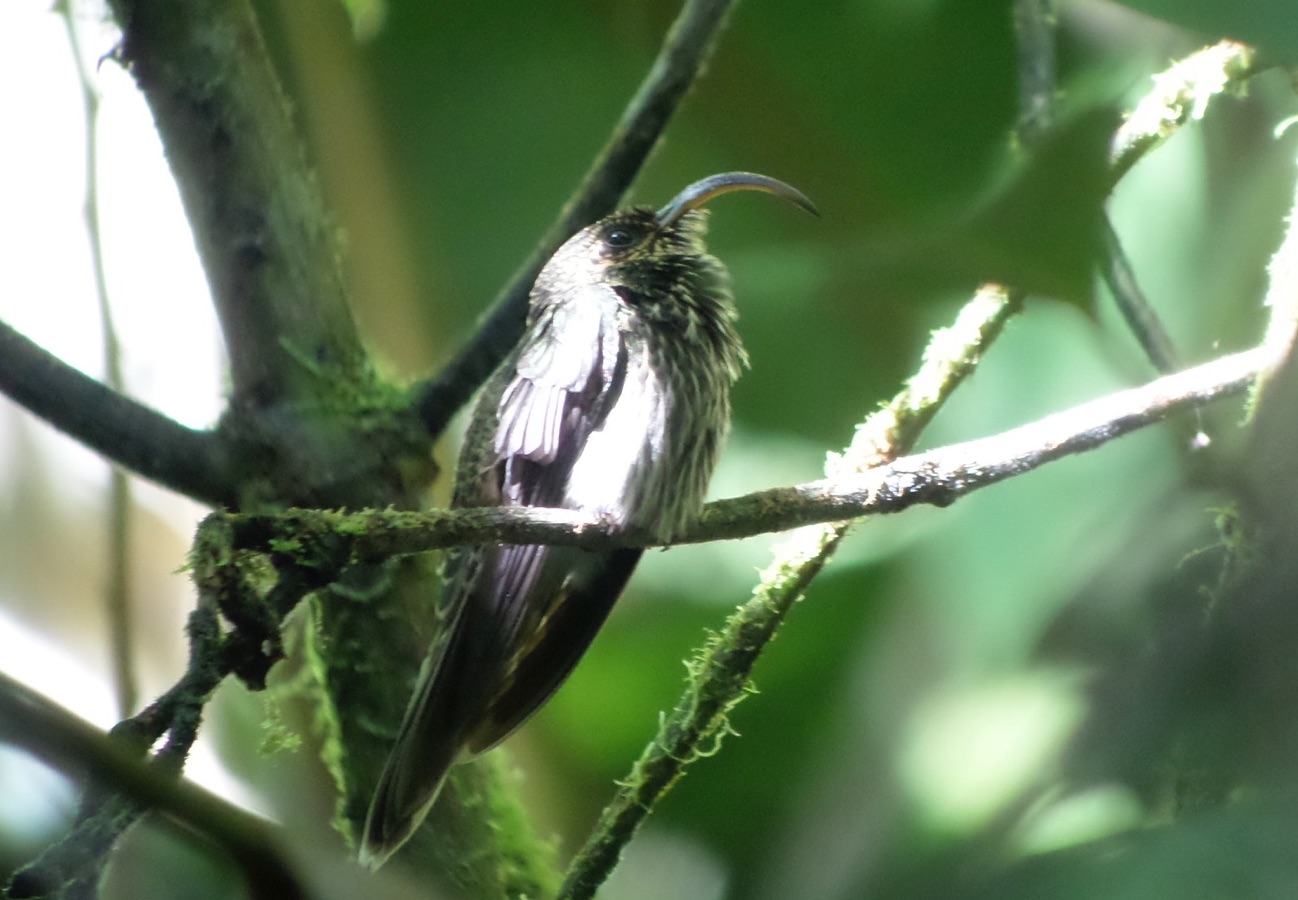NORTH-WEST ECUADOR 2023 Specialities of the Chocó Region
Day 1 ARRIVAL IN QUITO - LA CARRIONA HACIENDA (12th April)
Please note this is purely an arrival day and no birding activities are planned. If we arrive in daylight then around the garden of our accommodation we could see a few commoner species such as Eared Dove, Sparkling Violetear, Black-tailed Trainbearer, Blue-and-white Swallow, Cinereous Conebill, Golden-rumped Euphonia, Blue-and-yellow Tanager, Southern Yellow Grosbeak, Hooded Siskin and others. We are going to be staying at the edge of Quito, which in itself is a fabulous city surrounded by a series of extremely impressive volcanoes: Cotopaxi (5896m), Antisana (5704m), Cayambe (5796m) and our first arranged birding destination tomorrow morning of Pichincha (4701m), although we won’t be birding that high! When you consider that Quito is around 2850m our first night in Ecuador is going to be at quite a high altitude. Night at La Carriona Hacienda.
Day 2 YANACOCHA RESERVE – MINDO
We will set out early and drive along numerous country roads that zigzag their way ever higher up the west slope of Pichincha volcano and into the upper temperate and bird rich cloud forests to Yanacocha Reserve. What a great place to kick-start our birding and after the Covid-19 restrictions this is going to seem like a birding paradise! Walking effort is relatively easy and we should encounter some mixed flocks that could hold any number of species and it’s hard to name them all, but possibilities include Bar-bellied Woodpecker, Barred Fruiteater, White-throated and White-banded Tyrannulets, Pearled Treerunner, Azara’s and White-browed Spinetails, Tufted Tit-Tyrant, Rufous Wren, Spectacled Whitestart, Blue-backed Conebill, Superciliaried Hemispingus, Hooded, Black-chested and Scarlet-bellied Mountain-Tanagers, Golden-crowned Tanager and both Stripe-headed and Yellow-breasted (Rufous-naped) Brush-Finch amongst many others.
This site is probably most famous for its hummer feeders and the spectacle is something to behold with such delights as Shining Sunbeam, Mountain Velvetbreast, Great Sapphirewing, Tyrian Metaltail, Buff-winged Starfrontlet, Tyrian Metaltail Sapphire-vented and Golden-breasted Pufflegs, Rainbow-bearded Thornbill and the stunning Sword-billed Hummingbird all regular. The critically endangered and very rare Black-breasted Puffleg can also be seen here occasionally, whilst both Glossy and Masked Flowerpiercers are also regulars at the feeders. Other good birds within the reserve include Andean Guan, Andean Pygmy-Owl, Red-crested Cotinga, Undulated, Undulated, Tawny and Rufous Antpittas, Crowned Chat-Tyrant, Brown-bellied Swallow, White-browed Spinetail, Blackish & Ocellated Tapaculo, Great Thrush, Rufous Wren, and Grey-browed (Stripe-headed) and Rufous-naped Brush-Finches.
Once finished here we will head to Septimo Paraiso stopping at various sites along the way or if we pass any mixed feeding flocks. There are some more hummer feeders en-route where a wide variety of commoner species can be seen such as White-whiskered Hermit, White-necked Jacobin, Crowned Woodnymph, Andean Emerald, Sparkling and Brown Violetears, Rufous-tailed hummingbird, Velvet-purple Coronet, Green-crowned Brilliant, Purple-bibbed Whitetip, White-Booted Rocket-Tail and Violet-tailed Sylph. Other possibilities later in the day include Red-headed Barbet, Golden-headed Quetzal, Masked Trogon, Powerful and Golden-olive Woodpeckers, Gorgeted Sunangel, Red-faced Spinetail, Streaked Tuftedcheek, Pearled Treerunner, Streak-capped Treehunter, Montane Woodcreeper, White-throated and Black-capped Tyrannulets, Cinnamon Flycatcher, Smoke-coloured Pewee, Streak-throated Bush-Tyrant, White-capped Dipper, Mountain Wren, Russet-crowned Warbler, Western and Superciliaried Hemispingus, Brown-capped Vireo, Scarlet-bellied Mountain-Tanager, Golden-crowned, Beryl-spangled, Metallic-green, Grass-green, Golden and Silver-throated Tanagers, Blue-backed Conebill and maybe even a Tanager Finch. This will be the first of 4 nights at Septimo Paraiso.
Day 3 MASHPI
Mashpi Bird Sanctuary is one of current hotspots located on the western slope of the Andes and is home to a whole range of special Chocó birds We’ll get there early and maybe bird along the Mashpi Road first before entering the reserve, but whatever we decide to do first we know that the upper foothill forest of this excellent area has a great list of special localized birds to find. Exciting possibilities today include Indigo-crowned (or Purple) Quail-Dove, Pallid Dove, Cloud-forest Pygmy-Owl, Chocó Toucan, Chocó Trogon, Orange-breasted and Scaled Fruiteaters, Barred Puffbird Uniform Antshrike, Esmeraldas Antbird, Rufous-rumped Antwren, Pacific Tuftedcheek, Uniform Treehunter, Club-winged Manakin, Black and Rufous-brown Solitaires, Indigo Flowerpiercer, Chocó Vireo, Chocó Warbler, Chocó Brushfinch, Black-chinned Mountain-Tanager and a fine trio of Moss-backed, Glistening-green and Rufous-throated Tanagers.
Of course there’s plenty more opportunity to find other species and we are sure to bump into some mixed flocks that can be incredibly exciting, plus a good variety of more widespread species. It’s difficult to know exactly what will be around but there are possibilities to see Crested Guan, American Swallow-tailed Kite, Dusky Pigeon, Rose-faced and Bronze-winged Parrots, Maroon-tailed Parakeet, Striped Cuckoo, Rufous and Broad-billed Motmots, Crimson-rumped Toucanet, Red-headed Barbet, White-tipped Sicklebill, Green Thorntail, Slaty and Red-faced Spinetails, Scaly-throated Foliage-Gleaner, Streak-capped Treehunter, Zeledon’s Antbird, Greenish Elaenia, Rufous-winged and Ashy-headed Tyrannulets, White-thighed Swallow, Golden-winged Manakin, Olive-crowned Yellowthroat, Black-billed Peppershrike, Black-winged Saltator, Golden-collared Honeycreeper, Flame-faced, Golden, Silver-throated, Golden-naped, Scarlet-and-white, Lemon-rumped and Ochre-breasted Tanagers, Yellow-throated and Ashy-throated Bush-Tanagers and both Variable and Yellow-bellied Seedeaters amongst many others.
There are also some hummer feeders here that attract White-whiskered Hermit, Green-crowned Woodnymph, Brown Inca, Andean Emerald, Green-crowned Brilliant and Violet-tailed Sylph to name a few
Day 4 ANGEL PAZ RESERVE
No visit to NW Ecuador would be complete without a visit to Paz de las Aves, the famous private reserve that is well known for its antpitta feeding station. Regardless of whether you’ve been here before, there is always something of interest to be seen in this area and the prospect of yet more lifers! Yet the antpitta spectacle is certainly one to cherish with Moustached, Chestnut-crowned, Giant, Yellow-breasted and Ochre-breasted Antpittas all habituated to eat the provided earthworms in the recent past. These feeding stations have also attracted Dark-backed Wood-Quail, Rufous-breasted Antthrush and even Ocellated Tapaculo as well, so anything is possible! There’s also a lek of Andean Cock-of-the-Rocks to view as well, whilst pre-dawn and post-sunset visits could give us Lyre-tailed Nightjar and Colombian Screech-Owl. If time permits, there’s a nearby Oilbird cave to visit as well.
We’ll also spend time in some other areas including the grounds of our excellent lodge searching for species such as Wattled Guan, Golden-headed Quetzal, Toucan Barbet, Scaled Fruiteater, Uniform Antshrike, Zeledon’s Antbird, Slaty Antwren, Uniform Treehunter, Coopmans’s Elaenia (split from Lesser Elaenia), Nariño Tapaculo, Ochraceous Piha, Beautiful Jay, Tanager Finch and Ecuadorian Seedeater (split from Blue Seedeater).
Day 5 BELLAVISTA - ALAMBI - MINDO
We will spend the day at various locations amidst the usually mist-enshrouded subtropical forests of Bellavista and nearby Alambi Reserve, before dropping down to a couple spots closer to Mindo. There’s a whole bunch of quality target species from today, as well as a few surprises and we will be on the lookout for the always difficult White-faced Nunbird, as well as Powerful Woodpecker, Crested Quetzal, Gorgeted Sunangel, Flammulated Treehunter, Beautiful Jay, Spillman´s and Ocellated Tapaculos, and there’s another stab at Tanager Finch if still needed.
Other possibilities include Barred Hawk, Hook-billed Kite, Red-billed and White-capped Parrots, Rufous-bellied Nighthawk, Rufescent (Colombian) Screech Owl, Plate-billed Mountain-Toucan, Golden-headed Quetzal, Masked Trogon, Crimson-mantled and Powerful Woodpeckers, Toucan Barbet, Tawny-bellied Hermit, Wedge-billed Hummingbird, Purple-bibbed Whitetip, White-Booted Racket-tail, Green-and-black Fruiteater, Olivaceous Piha, Pearled Treerunner, Spotted and Rusty-winged Barbtails, Streaked Tuftedcheek, Spotted, Lineated and Montane Woodcreepers, Slaty Antwren, Streak-headed Antbird, Sierran Elaenia, White-tailed Tyrannulet, Streak-necked, Ornate, Flavescent, Cinnamon and Golden-crowned Flycatchers, Bronze-olive Pygmy-Tyrant, Barred Becard, Grey-breasted Wood-Wren, Brown-capped Vireo, Spectacled and Slate-throated Whitestarts, Russet-crowned, Black-crested and Three-striped Warblers, Turquoise Jay, Dusky Bush-Tanager, Blue-winged Mountain-Tanager, Western Hemispingus, White-winged and Chestnut-capped Brushfinches, Chestnut-breasted Chlorophonia, Fawn-breasted, Rufous-throated, Flame-faced, Golden, Golden-naped, Beryl-spangled, Metallic-green, Blue-capped, White-winged and Black-capped Tanagers. This will be our last night at Septimo Paraiso
Day 6 KAPARI LODGE
This morning we will head to Kapari Lodge, located in the tropical foothills along the Rio Blanco. There are a number of forest trails where Brown Wood Rail, Rufous-fronted Wood-Quail, Purple (Indigo-crowned) Quail-Dove, Pallid Dove and Chocó Screech-Owl reside, Crested Owl, along with Maroon-tailed Parakeet, Chocó Trogon, Broad-billed and Rufous Motmots, Lanceolated Monklet, Brown-billed Scythebill, Spotted Woodcreeper, Esmeraldas Antbird, Golden-winged Manakin and much more.
There are also some feeders where we can see species such as Pale-mandibled Aracari, Red-headed Barbet, Ecuadorian Thrush, Blue Dacnis, Orange-billed Sparrow and Silver-throated Tanager. Night at Kapari Lodge.
Day 7 23 DE JUNIO COMMUNITY
We will visit the 23 de Junio Community and have the whole day to look for Long-wattled Umbrellabird. Other possibilities include Sickle-winged Guan, Barred Forest Falcon, Spot-fronted Swift, Choco Toucan, Guayaquil Woodpecker, Choco Tyrannulet, Golden-winged Manakin, Nariño and Spillmann’s Tapaculo, Turquoise Jay, Yellow-collared Chlorophonia, Scrub Blackbird, Choco Brushfinch, Ochre-breasted and Rufous-throated Tanagers amongst others. Night at Kapari Lodge.
Day 8 MASHPI or SILANCHE
We have options today and will visit one of two well-known reserves. At Mashpi there’s a good chance of species such as Rufous-fronted Wood-Quail, Tawny-faced Quail, Chocó Poorwill, Chocó Trogon, the always-tricky Chocó Vireo, as well as Spot-crowned Antvireo, Pacific Tuftedcheek, Uniform Treehunter, Northern Schiffornis, Esmeraldas Antbird, Bronze-olive Pygmy-Tyrant, White-throated Spadebill, Band-rumped Swift, Black Solitaire, Pale-eyed Thrush, Chocó Warbler, Indigo Flowerpiercer, Moss-backed, Emerald, Flame-faced and Ochre-breasted Tanagers, Yellow-collared Chlorophonia, with a more outside chance of Long-wattled Umbrellabird as well. The chances of seeing Rufous-crowned Pittasoma are much slimmer than a few years ago, but you never know!
If we go to Rio Silanche Reserve then we will target species along the trail or from the canopy tower such as Dusky Pigeon, Striped Cuckoo, Guayaquil Woodpecker, Yellow-throated and Choco Toucans, Pale-mandibled Aracari, White-tailed Trogon, Rufous-tailed Jacamar, Violet-bellied, Blue-chested and Purple-chested Hummingbirds, Barred and White-whiskered Puffbirds, Black-headed Antthrush, Bicolored and Chestnut-backed Antbirds, Pacific, Dot-winged and Checker-throated Antwrens, Streak-headed Woodcreeper, Ruddy Foliage-gleaner, Red-billed Scythebill, Plain Xenops, Wedge-billed Woodcreeper, Sooty-headed and Choco Tyrannulets, Slaty-capped and Olive-striped Flycatchers, Yellow-margined Flatbill, White-thighed Swallow, Pacific Hornero, Masked Water-Tyrant, Cinnamon Becard, Lesser Greenlet, Blue-necked, Grey-and-gold, Tawny-crested, Scarlet-browed and White-shouldered Tanagers and Yellow-tufted Dacnis,
Once we have finished birding this morning we will set out on a 90-minute boat ride in our motorized dugout canoes, and the journey could produce Little Blue or Fasciated Tiger-Herons. This simple lodge is basically the gateway to visit the remarkable Cotacachi-Cayapas Reserve. There’s an amazing list of birds in this prime lowland Chocó area and no doubt if there’s any time we will make our first exploration before settling into our rooms that offer either an ocean view or a jungle view. Night at xxxx
Days 9 - 10 PLAYA DE ORO RESERVE
This is one of those tours that keeps getting better and better every day! And today is no exception as we begin our exploration of this amazing area with some pre-breakfast birding in the immediate vicinity of our lodge for species such as the Tawny-faced Quail, Uniform Crake, Black-headed Antthrush, the Chocó endemic Stub-tailed, Spotted and Dusky Antbirds, Streak-chested Antpitta and Brown-capped Tyrannulet. This can be a good as place as any to observe some decent mixed feeding flocks as well, with species such as Striped Woodcreeper, Tawny-crested Tanager, even Blue-whiskered Tanager, One-coloured Becard and Purple Honeycreeper among others.
Moving along the narrow, muddy trails we will be targeting many of the rarest and hardest to find Chocó specialties of the area, as well as a number of other really tricky species. High on our wishlist are species such as Berlepsch’s Tinamou, Baudo Guan, Plumbeous Hawk, Chocó Screech Owl Chocó Poorwill, Great-green Macaw, Rose-faced Parrot, Chocó Poorwill, Bronzy Hermit, Purple-chested Hummingbird, Bronze-tailed Plumeleteer, Hoary Puffleg, Tooth-billed Hummingbird, Stripe-billed Aracari, Five-coloured Barbet, Chocó and Lita Woodpeckers, Blue Cotinga, Black-tipped Cotinga, Black-breasted Puffbird, Slate-throated Gnatcatcher, Chocó Tyrannulet, Pacific Flatbill, Griscom’s (Moustached) Antwren, Stripe-throated Wren, Sapayoa (a taxonomic conundrum and now placed in its own family, and a regular follower of mixed feeding flocks that roam the area), Ocellated and Stub-tailed Antbirds, Rufous-crowned Antpitta, Spot-crowned Antvireo, Rufous Piha, the Chocó race of Green Manakin, Dagua Thrush (split from White-throated Thrush), Beautiful Jay, Blue-whiskered, Scarlet-browed, Lemon-spectacled, Rufous-winged, Golden-chested, and Grey-and-Gold Tanagers, as well as the delightful Scarlet-breasted Dacnis.
There are a seemingly inexhaustible supply of new birds for our list here and we could also see Great Tinamou, Crested Guan, Plumbeous Kite, Laughing Falcon, Dusky Pigeon, Pale-mandibled Aracari, Chocó and Black-mandibled Toucans, White-tailed, Gartered, Black-throated Trogon, Broad-billed Motmot, Rufous-tailed Hummingbird, Stripe-throated Hermit, Band-tailed Barbthroat, Green Thorntail, Purple-crowned Fairy, Pacific Parrotlet, Blue-headed Parrot, Olivaceous Piculet, Black-cheeked and Guayaquil Woodpeckers, Orange-fronted Barbet, White-whiskered Puffbird, Pacific Hornero, Dusky Leaftosser, Western Woodhaunter, Buff-throated Foliage-gleaner, Northern Barred, Black-striped, Plain-brown, Black-striped, Spotted and Streak-headed Woodcreepers, Speckled Mourner, Black-crowned Antshrike, Spotted, Bicoloured and Ocellated Antbirds, Dot-winged, Pacific and Dot-backed Antwrens, Sooty-headed, Brown-capped and Yellow-crowned Tyrannulets, Grey Elaenia, Western Sirystes, Black-capped Pygmy-Tyrant, Yellow-margined Flatbill, Sulphur-rumped Flycatcher, White-ringed and Ruddy-tailed Flycatchers, Red-capped and White-bearded Manakin, Black and Cinnamon Becards, Slaty-capped Shrike-Vireo, Band-backed and Bay wrens, Southern Nightingale and Song Wrens, Buff-rumped Warbler, Yellow-tufted Dacnis, Guira, Grey-and-gold, Blue-necked, Golden-hooded, Bay-headed, Purplish-mantled, Lemon-rumped, Orange-fronted, White-shouldered, Dusky-faced and Tawny-crested Tanagers, Slate-coloured Grosbeak, Yellow-tailed Oriole and Yellow-bellied Siskin. Nights at the rustic Playa de Oro Lodge.
Day 11 ALTO TAMBO
We will leave early for our journey to the lower Andean foothills of western Ecuador of Alto Tambo. Species we could see today include Brown Woodrail, Rufous-headed Chachalaca, Slaty-tailed Trogon, Stripe-billed Aracari, Green Thorntail, Black-breasted Puffbird, Five-coloured Barbet, Black-tipped Cotinga, Lita, Chocó, Cinnamon and Crimson-bellied Woodpeckers, Russet Antshrike, Chocó Tapaculo, Black-capped Pygmy-Tyrant, Chocó Warbler, Scarlet-breasted Dacnis, Yellow-green Bush-Tanager, Yellow-collared Chlorophonia, Blue-whiskered and the amazing Golden-chested Tanager. Night at Hacienda Primavera.
Days 12 - 13 CHICAL ROAD
These two days are particularly exciting, as we will explore a number of sites along the famous Chical Road and Alto Tambo areas. Another huge list of birds is possible over these couple of days and no doubt we will bump into yet more exciting, mixed feeding flocks. We will be on the lookout for Plate-billed Mountain-Toucan, Hoary Puffleg, Blue-headed Sapphire, White-tailed Hillstar, Long-tailed Sylph, Chocó and Yellow-vented Woodpeckers, Toucan Barbet, White-ringed and Tufted Flycatchers, Star-chested Treerunner, Stub-tailed Antbird, Black Solitaire, Chocó Tapaculo, Beautiful Jay, Yellow-green Bush-Tanager, Rufous-winged, Bluish-mantled, Golden-chested, Saffron-crowned, Glistening-green, Emerald, Rufous-crested, Scarlet-and-white, Purplish-mantled and Scrub Tanagers, Black-chinned Mountain Tanager and Ruddy-breasted Seedeater. It’s going to be a memorable couple of days here!
Day 14 OTAVALO - QUITO - END OF TOUR (25th April)
We plan to spend the first couple of hours chasing new species in the Otavalo area before setting out on the longish drive back to Quito. Of course we will make any stops as required to check out feeding flocks and other interesting areas. One particular planned stop is at Laguna San Pablo for the hoped for Ecuadorian Rail, as well as Yellow-billed Pintail, Andean Coot, Andean Duck, Andean Duck, Andean Teal, Subtropical Doradito, Coopman’s Elaenia, Scrub Tanager, and a whole load more! And we’ll get you to the airport in plenty of time for your international flights.
.
All photos copyright Juan Carlos Calvachi

